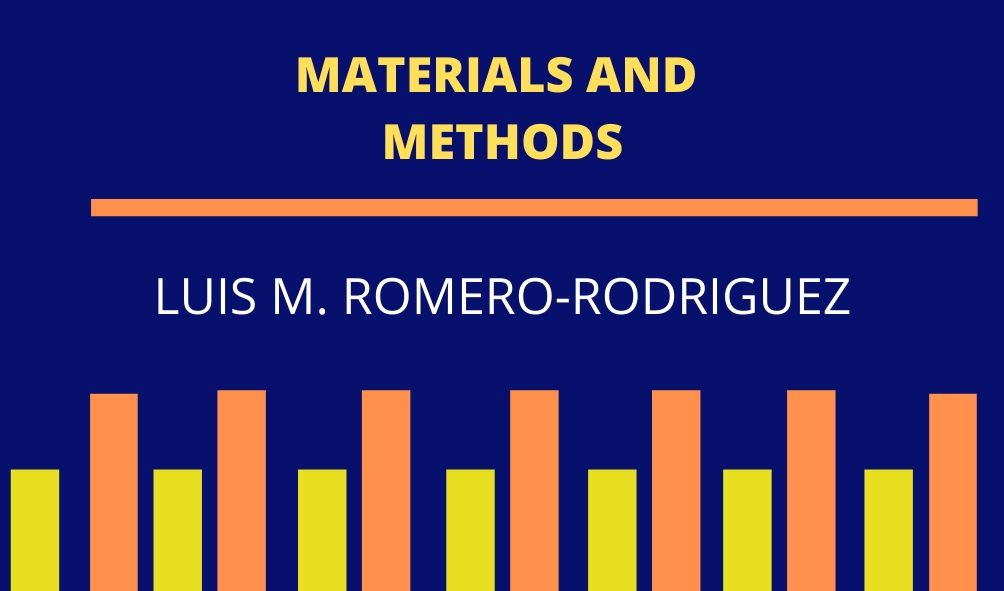Should We Include the Experimental Section of the Research in a Review Article
Author: Luis-Miguel Romero – Translation: Erika-Lucia Gonzalez-Carrion

Materials and methods is mayhap the most of import heading to evaluate the general quality of any research broadcasting product, since it is the ane that explains to the readers what procedures, approaches, designs and treatment we have carried out in the enquiry, which will allow u.s.a. to replicate the studies, understand the linearity between the approach of the objectives and the results obtained, determine their suitability and relevance, as well as evidence of any bias in the way in which the report was designed and carried out.
Plainly, the way in which this section is unremarkably written changes depending, on one hand, on the scientific discipline, just on the other – and to a large extent – on the editorial and norms of the publication (run into guidelines of Comunicar Journal). At that place are even unlike ways of writing this section if it is an empirical investigation or a more than analytical written report (art states, based theory, etc.). All the same, the way in which the research was conducted should always be clearly and neatly stated in the text, as this is what will allow us to understand beginning-hand the design, scope, data collection techniques, sample and sampling strategies, intervals of the study, amidst other aspects that contribute to give objective value and reliability to the results obtained.
In this line, the option of materials and methods will depend in first place on the objectives of the investigation and the hypotheses (if any), as these will initially make up one's mind:
- The blazon of research: documentary, field, semi-experimental or experimental.
- Research pattern: Quantitative, qualitative or mixed.
- The telescopic of the enquiry: Exploratory, descriptive, correlational, explanatory or predictive.
Likewise, the materials and methods section explains the techniques that accept been carried out, always justifying them according to the objectives and citing previous studies that have determined their scientific validity. In this sense, the nearly common in Social Sciences is that the techniques are organized according to the objectives, although some disciplines normally declare them in order of importance.
One of the most common means of exposing the sub-sections of this heading is every bit follows:
- General aspects of the research: type, design, and telescopic. The dates or intervals of the study are also usually identified.
- Sample: individuals participating in the report or elements that make up the sample (documents, spaces, etc.) and inclusion/exclusion criteria. Sampling strategies and techniques (probabilistic or non-probabilistic). Statistical validity and accurateness of the sample (confidence, a margin of mistake, etc.).
- Instruments: Explanation of the instruments used for data collection, variables, dimensions, indicators, their design, construction, validity, and reliability; also equally the justification of the suitability of information technology for the scope of the objectives ready. It must as well be stated at this point how the data drove procedure was performed.
- Data processing organisation: Development of the database, software used for data collection (eg Survey Monkey, Google Forms …), systems used for information processing (eg SPSS, R, AtlasTi, MaxQDA …). Many times authors are asked to make the database (and even codes) bachelor to readers and/or reviewers in an open up repository such as StackOverFlow or OpenICPSR.
- Ethical aspects: Some publications require researchers to declare compliance with ethical research standards in this section (for example: ideals commission, informed consent, information processing, amidst other details to identify the care with which has treated the sample).
As the "materials and methods" department is the explanatory and justifying intermediary of the processes that occur between the objectives and the results obtained, nether no circumstances may results exist exposed that were not evidenced through the alleged techniques. In this regard, readers and reviewers are very grateful that the results are presented in the order in which the objectives and methods were explained, in order to follow an ordered sequence.
mcwilliambeerbeen.blogspot.com
Source: https://www.revistacomunicar.com/wp/school-of-authors/importance-in-the-section-materials-and-methods-in-the-scientific-articles/